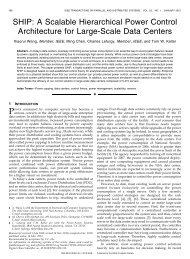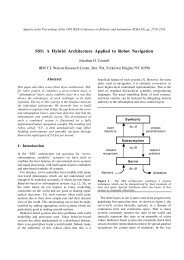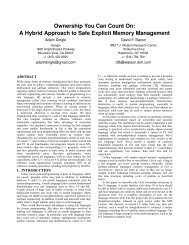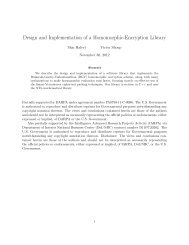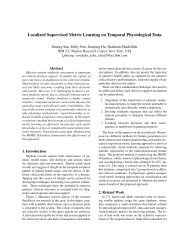6.2 JPEG Compression <strong>and</strong> DecompressionTo achieve color image compression, schemes such as JPEG first transform the image to a color encodingother than the RGB encoding <strong>and</strong> then perform quantization. Such color encodings can be related to theRGB encoding by a color-transform matrix C ∈ R 3×3 . The columns of C form a different basis for thecolor space spanned by the R, G, <strong>and</strong> B vectors. Hence an RGB encoding w RGBcan be transformed to theC encoding vector as C −1 w RGB; the image P is mapped to C −1 P . For example, the matrix relating theRGB color space to the ITU.BT-601 Y CbCr color space is given by [27]⎡ ⎤ ⎡⎤ ⎡ ⎤w Y0.299 0.587 0.114 w R⎣w Cb⎦ = ⎣−0.169 −0.331 0.5 ⎦ ⎣w G⎦. (33)w Cr0.5 −0.419 −0.081 w BThe quantization step is performed by first choosing a diagonal, positive (non-zero entries are positive),integer⌈quantization matrix Q, <strong>and</strong> then computing the quantized (compressed) image from C −1 P as P c =Q −1 C −1 P ⌋ , where ⌈.⌋ st<strong>and</strong>s for the operation of rounding to the nearest integer. JPEG decompressionconstructs P d = CQP c = CQ ⌈ Q −1 C −1 P ⌋ . Larger Q’s achieve more compression but at the cost ofgreater distortion between the decompressed image P d <strong>and</strong> the original image P .In practice, the image matrix P is first decomposed into different frequency components P ={P 1 , P 2 , ... ,P k }, for some k > 1 (usually k = 64), during compression. Then, a commoncolor transform C is applied to all the sub-matrices P 1 , P 2 , ... ,P k , but each sub-matrixP i is quantized with a different quantization matrix Q i . The compressed image is P c ={P c,1 ,P c,2 ,...,P c,k } = {⌈ Q −1 ⌋ ⌈ ⌋ ⌈ ⌋}1 C−1 P 1 , Q−12 C−1 P 2 ,... , Q−1k C−1 P k , <strong>and</strong> the decompressed imageis P d = {CQ 1 P c,1 ,CQ 2 P c,2 ,...,CQ k P c,k }.During compression, the JPEG compressed file format stores the matrix C <strong>and</strong> the matrices Q i ’s alongwith P c . These stored matrices are utilized to decompress the JPEG image, but are discarded afterward.Hence we refer to the set {C,Q 1 ,Q 2 ,... ,Q k } as the compression history of the image.6.3 JPEG CHEst Problem StatementThis paper’s contributions are motivated by the following question: Given a decompressed image P d ={CQ 1 P c,1 ,CQ 2 P c,2 ,... ,CQ k P c,k } <strong>and</strong> some information about the structure of C <strong>and</strong> the Q i ’s, can weestimate the color transform C <strong>and</strong> the quantization matrices Q i ’s? As {C,Q 1 ,Q 2 ,... ,Q k } comprisesthe compression history of the image, we refer to this problem as JPEG CHEst. An image’s compressionhistory is useful for applications such as JPEG recompression [5, 22, 23].6.4 Near-<strong>Orthogonal</strong>ity <strong>and</strong> JPEG CHEstThe columns of CQ i P c,i lie on a 3-D lattice with basis CQ i because P c,i is an integer matrix. The estimationof CQ i ’s comprises the main step in JPEG CHEst. Since a lattice can have multiple bases, wemust exploit some additional information about practical color transforms to correctly deduce the CQ i ’sfrom the CQ i P c,i ’s. Most practical color transforms aim to represent a color using an approximately rotatedreference coordinate system. Consequently, most practical color transform matrices C (<strong>and</strong> thus, CQ i ) canbe expected to be almost orthogonal. We have verified that all C’s used in practice are weakly ( π3 + ɛ) -orthogonal, with 0 < ɛ ≤ π 6 .4 Thus, nearly orthogonal lattice bases are central to JPEG CHEst.4 In general, the stronger assumption of π -orthogonality does not hold for some practical color transform matrices.316
6.5 Our ApproachOur approach is to first estimate the products CQ i by exploiting the near-orthogonality of C <strong>and</strong> to thendecompose CQ i into C <strong>and</strong> Q i . We will assume that C is weakly ( π3 + ɛ) -orthogonal, 0 < ɛ ≤ π 6 .6.5.1 Estimating the CQ i ’sLet B i be a basis of the lattice L i spanned by CQ i . Then, for some unimodular matrix U i , we haveB i = CQ i U i . (34)If B i is given, then estimating CQ i is equivalent to estimating the respective U i .Thanks to our problem structure, the correct U i ’s satisfy the following constraints. Note that theseconstraints become increasingly restrictive as the number of frequency components k increases.1. The U i ’s are such that B i U −1iis weakly ( π3 + ɛ) -orthogonal.2. The product U i Bi−1 B j Uj−1 is diagonal with positive entries for any i,j ∈ {1,2,... ,k}.This is an immediate consequence of (34).If in addition, B i is weakly ( π3 + ɛ) -orthogonal, then3. The columns of U i corresponding to the shortest columns of B i are the st<strong>and</strong>ard unit vectors times ±1.This follows from Corollary 1 because the columns of both B i <strong>and</strong> CQ i indeed contain all shortestvectors in L i up to multiplication by ±1.4. All entries of U i are ≤ κ(B i ) in magnitude.This follows from Theorem 3.We now outline our heuristic.(i) Obtain bases B i for the lattices L i , i = 1,2,... ,k. Construct a weakly ( π3 + ɛ) -orthogonal basis B lfor at least one lattice L l , l ∈ {1,2,... ,k}.(ii) Compute κ(B l ).(iii) For every unimodular matrix U l satisfying constraints 1, 3 <strong>and</strong> 4, go to step (iv).(iv) For U l chosen in step (iii), test if there exist unimodular matrices U j for each j = 1,2,... ,k,j ≠ lthat satisfy constraint 2. If such a collection of matrices exists, then return this collection; otherwisego to step (iii).For step (i), we simply use the LLL algorithm to compute LLL-reduced bases for each L i . Such basesare not guaranteed to be weakly ( π3 + ɛ) -orthogonal, but in practice, this is usually the case for a number ofthe L i ’s. Instead of LLL, the method proposed in [25] could be also employed (as suggested by the referees).In contrast to the LLL, [25] always finds a basis that contains the shortest lattice vector in low-dimensionallattices (up to 4-D) such as the L i ’s in our problem. In step (iv), for each frequency component j ≠ l, wecompute the diagonal matrix D j with smallest positive entries such that Ũj = Bj−1 B l U −1lD j is integral, <strong>and</strong>then test whether Ũj is unimodular. If not, then for the given U l , no appropriate unimodular matrix U j exists.The overall complexity of the heuristic is determined mainly by the number of times we repeat step(iv), which equals the number of distinct choices for U l in step (iii). This number is typically not very large17









